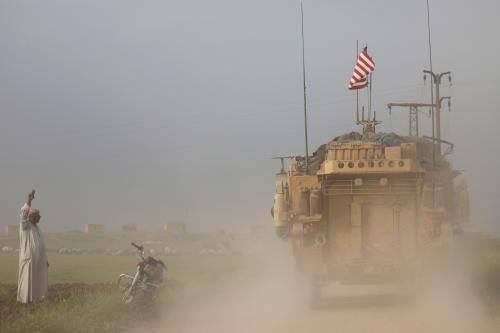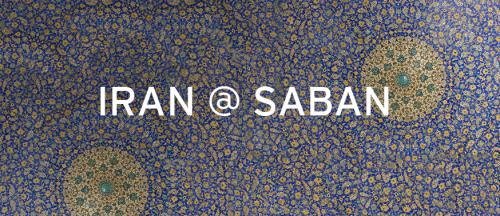Content from the Brookings Doha Center is now archived. In September 2021, after 14 years of impactful partnership, Brookings and the Brookings Doha Center announced that they were ending their affiliation. The Brookings Doha Center is now the Middle East Council on Global Affairs, a separate public policy institution based in Qatar.
On Thursday, the United States conducted air strikes on Iran-backed Shiite militia groups fighting alongside the Bashar Assad regime in Syria. Indeed, since responding to the Syrian regime’s chemical weapons attack on Khan Sheikhoun in early April, the Trump administration is reportedly debating escalating U.S. involvement there and, while Thursday’s airstrike was aimed at repelling the militias’ advance towards a base used by the United States and its allies, Washington must prepare itself for a possible confrontation with Iran, which wields a complex (but resistible) influence in Syria that allows it to dominate realities on the ground. Through this influence, Iran and its Shiite militia proxies will ultimately shape the future of the Syrian state and society—including its governing and security structures, economic environment (which will determine the beneficiaries of the estimated $200 billion needed to reconstruct the country), and its foreign relations.
What can the United States realistically do to counter Iranian influence in Syria?
RIPE CONDITIONS
Since 2012, militia groups armed, financed, and trained by Iran have consolidated their hold on the ground. They played a pivotal role in capturing Aleppo in December and in shifting the balance of power in favor of the regime and its Iranian patrons. This comes as no surprise: Unlike its rivals for influence in Syria, Iran’s clerical rulers have spent almost four decades cultivating armed groups across the Arab world to enhance their influence.
Iran has proven willing and capable of capitalizing on conflict and state fragility in Syria and the region at large. Whereas Iran used to just provide arms and cash to Hamas, Islamic Jihad, and Saudi Hezbollah—or allow jihadi groups such as Ansar al-Islam (the previous incarnation of al-Qaida in Iraq and the so-called Islamic State) to use Iranian territory for launching attacks—the region’s civil wars have provided new opportunities for Iranian influence. Particularly since the Arab uprisings, Tehran has been able to establish, empower, and entrench its proxy organizations: Its proxies, like Lebanon’s Hezbollah or the plethora of Iraqi Shiite insurgent groups that it established in the 1980s and 1990s, once had limited prospects against conventional armies, but in recent years have become predominant wielders of power and authority as a result of state fragility and the weakening of the state system in the Middle East. And Iran has a distinct advantage: It has decades of experience trying, testing, and learning from the kind of proxy warfare currently engulfing the Arab world.
Iran has a distinct advantage: It has decades of experience trying, testing, and learning from the kind of proxy warfare currently engulfing the Arab world.
IRAN AND ITS PROXIES IN SYRIA
Tehran’s patronage of armed groups has yielded significant dividends in recent years. Its Shiite militia proxies in Iraq are fully integrated into the political system and function parallel to the much weaker Iraqi military. When the Syria conflict unfolded, these militias extended their operations across the border and established affiliates in Syria to fight alongside the Bashar Assad regime.
Along with Lebanon’s Hezbollah (which made its mark by capturing the strategic town of Qusayr in 2013), Iraq’s Shiite militias have played a decisive role in shifting the balance of power in the Assad regime’s favor. To be clear, this is an extensive network of leaders, fighters, resources, and weapons that span the region into Afghanistan. And Iran doesn’t have to direct each and every one of these groups—instead, it relies on its “principal” militia organizations, such as Iraq’s Badr Brigade or Lebanon’s Hezbollah to manage an array of subsidiaries.
Tehran organizes and finances these groups, but they have enough autonomy to allow them to acquire their own local resources and support bases. One part of the strategy is militarily taking hold and controlling territory; the other involves transforming armed groups into socio-cultural actors, especially where state control is weak. These groups sustain and legitimize their presence through threats to local communities (and the fear it generates), often drawing on sectarian narratives of victimhood.
The religious and cultural dimension to Iran’s strategy helps its proxies transition from armed group to socio-cultural movement and then (ideally, from the Iranian perspective) an integrated component of the political system (by integrating militias either into the army or police force or as auxiliary forces parallel to the military).
It’s not entirely clear how much local support Iran’s proxies have in Syria. But worrying reports suggest that the Assad regime and Iran continue to manipulate the country’s demographic map—by way of forced displacements—that could exacerbate the problem. Moreover, where there is no state, local communities have no choice but to accept and support the armed groups that, from their perspective, provide security and services in the absence of viable alternatives.
WHAT TO DO
All is not yet lost for the United States.
It should start by identifying what Iran wants in Syria. I’d posit that the answer is something between Lebanon and Iraq: a state that is weak enough so that Iran can shape the state’s identity but not so weak that it disintegrates. By this logic, Iran would want a weak national army, sect-based institutions, and polarizing politics and values. Collectively, these reduce the prospects of a national identity emerging that could bring Syria’s different communities together and that then produces a strong and stable state that would be detrimental to Iran’s long-term interests.
Iran’s own experience with encirclement in the region (being surrounded by hostile Arab states with powerful armies, immense resources, and Western allies that could threaten the regime or force it into subjugation) is what shapes its foreign policy outlook, bearing in mind that the Islamic Revolutionary Guard Corps personnel that lead Iran’s engagements in Syria and Iraq are veterans of the grueling eight-year war with Iraq in the 1980s.
An assertive U.S. presence in the Middle East reassures America’s friends and allies and worries its enemies.
U.S. policymakers must appreciate these dynamics. In the absence of a full-scale military engagement in Syria, the United States should initially focus on containment. The airstrikes last month, along with Thursday’s airstrikes, constituted a very preliminary step in that direction. An assertive U.S. presence in the Middle East reassures America’s friends and allies and worries its enemies.
But truly countering Iran will require a long-term approach to a complex and constantly evolving problem, not piecemeal measures. Ideally, the United States would match the dedication and resources that Iran has invested in Syria. In reality, the Trump administration, like its predecessor, seems to be searching for a more attainable approach.
Some have suggested that the solution may be a deal with Russia to rein in Iran and its proxies, but Moscow’s hands are tied—as Iran’s disruption of the Aleppo evacuation showed, Russia has limited leverage over Tehran’s actions in Syria. And as the Assad regime and Iran’s proxies make further gains, they are likely to move further away from Russia’s sphere of influence. That presents an opportunity for Washington to coordinate with Moscow as it attempts to contain Iran’s influence in Syria.
Safe zones also offer a more attainable approach to constraining Iranian influence. That would establish a meaningful foothold in Syria and should include building on Washington’s military cooperation with Syria’s Kurds to ensure Syrian Kurdistan (or Rojava) is not co-opted or forced into subjugation by either the Assad regime or Iran. This also requires encouraging the YPG to become a more inclusive actor and allaying Turkish concerns that an emboldened Rojava will undermine its own national security. The United States would have to commit extensive resources to Syria’s safe zones (the multiple safe zones, if Rojava is included), which will be far more complex and dangerous than the safe zone established in northern Iraq in the 1990s, as well as an understanding of past mistakes.
Syria’s future will most likely be a confederal model where power is devolved to different regions. Iran’s strategy for Syria is accordingly developed to prepare it for, and allow it to, dominate such governing structures. The United States must position itself to prevent this—for example, if or when Iran attempts to integrate its proxies into the Syrian state or aims to constitutionalize and legitimize their presence. If Iran’s proxies in Syria attach themselves to political parties, NGOs and other socio-cultural institutions, they may fleece the economy as international resources flow in. As the cases of Iraq, Afghanistan, and Lebanon show, militias can become serious economic actors. Combined with using its military might as leverage against Iran’s proxies, the United States must keep one eye firmly focused on the war economy that underpins the conflict in Syria, and the eventual international support that will hopefully underpin some form of peaceful settlement. This will require hurting Iran’s proxies financially to weaken their capacity to maintain control and engage in the business of governance, as well as helping to provide local communities with viable alternatives for economic livelihood.
In short, U.S. presence in Syria equals power. Greater U.S. presence means a greater capacity to play a more proactive role—and that brings more problems than solutions for the Iranians.










Commentary
Iran’s complicated but resistible influence in Syria
May 19, 2017